(All words and photos by Anthony Marr)
I love a butterfly as much as a horse, a horse as much as a deer, a deer as much as a tiger, a tiger as much as a dolphin, and a dolphin as much as myself. When I fight for them, therefore, it is a matter of self-defense, every being's universal right. There is no current law to support the legitimacy of my self-defense claim, but it rules within me. I'm a man of peace, but not a pacifist. I've been called a warrior, whose pen is his sword. And when I speak for Mother Earth, it is Mother Earth speaking through me, for I am not apart from her, but an integral part of her.
A war is not what I would wish to be born into, but there are certain things in the universe beyond ones control, including the cards you are dealt. Like a new cell in the body of a woman being raped, I was born in China during the invasion by Japan. I suppose I was born to know shame, and I did know it. But enough is enough. There comes a time when shame must turn to something else. Some may say "Forgiveness". But those who say "forgive" did not see one villager being forced to skin another alive, at pain of being skinned alive himself by the village he refused to skin alive. So, not me. Not with Japan. Not yet. Not when Japan is still trying to rewrite history to black out its own guilt. The Holocaust wiped out 6 million Jews. The Japanese massacred 20 million Chinese civilians. The Yangtze River ran red with human blood for ten days. So, who is an Anglican to tell a Chinese to forgive?

I should be thankful. I consider myself very lucky to have been born at all. My mother escaped being captured as a "comfort woman" (disposable sex slave) by hiding in a pond, breathing through a hollow lotus stalk, when a distant neighbor protected her own daughter by telling the Japanese that the most beautiful girl in the village lived in my grandfather's house. Had she not taken that decisive and courageous step, I would not be here philosophising about it. I owe her my life, in more ways than one, and just to begin with.
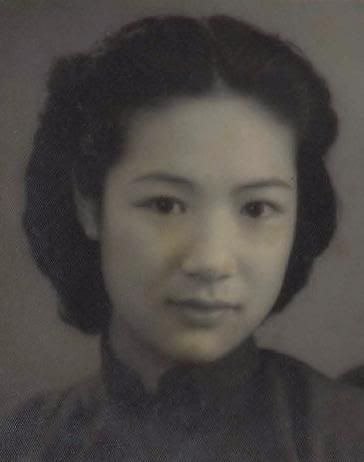
To me, forgiveness, like respect, must be earned. And Japan has done nothing to earn my forgiveness. What I see (present tense) instead is the same blood lust, not against the Chinese now, but against other beings just as sentient or even more so. Instead of national imperialism, it is now speciestic imperialism. The arrogance and brutality are no less.
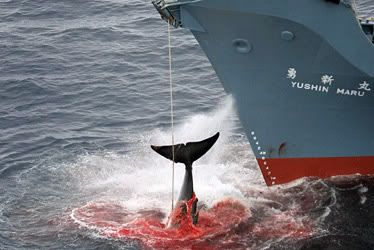
I see it as my warrior's honor to pick anyone involved in the Japanese whaling and dolphining industries as a choice enemy. I am of such a nature that the slightest remorse from an enemy will start me melting, but before I can find forgiveness for an enemy, I must strive to defeat it. Sometimes, to defeat an enemy is the first step of forgiving him. This is the code I live by.
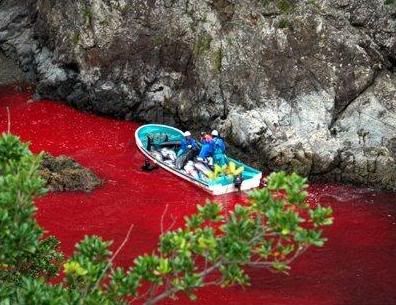
Does my fighting Japanese whaling and dolphining have a revenge element? Perhaps. I haven't searched my soul deeply enough to know for sure. But I cannot deny that whenever I envisage Japan defeated on whaling and dolphining, I taste something very sweet. No, to defeat Japan is not my life's goal. It's not great enough to be worth it. The sweetness comes from the imagination that the whales and dolphins have been saved. At least, this is what I try to convince myself. I know this to be by and large true, but I'm not so pure as to aspire to sainthood. No, I do not hate the Japanese people. I have met many Japanese people during my months in Japan, and as a rule I respect them, and even admire them in some ways. But this respect and admiration does not eclipse my determination to defeat them as an attitude and a tradition.
So, in 2004 and 2005, I went to Japan to do my part, targeting three of the most evil of places on Earth: Futo, Shimonoseki, and of course Taiji.
The first place I went to was Futo. The first time I heard about Futo was via this video depicting dolphin slaughter, by which I was instantly appalled. Within seconds materialized the henceforth unshakable deterimination to teriminate what appalled me by whatever means necessary. (Warning: extremely graphic and sickening.)
I arrived at Futo by car from Tokyo, by which time I had heard of the heroic ex-dolphin-killer Ishii Izumi who had undergone a transformation of sorts, and has turned his back on dolphin-killing and made his ex-killer boat into a whale-watching vessel. This had put a stop to the dolphin-killing due to the unfavorable reactions of the whale-watching tourists. When I was there, no dolphin-killing took place.
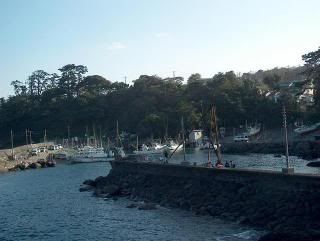
Instead, Izumi took me out whale-watching in his boat, and within 15 minutes, we came across two sperm whales well within sight of land.
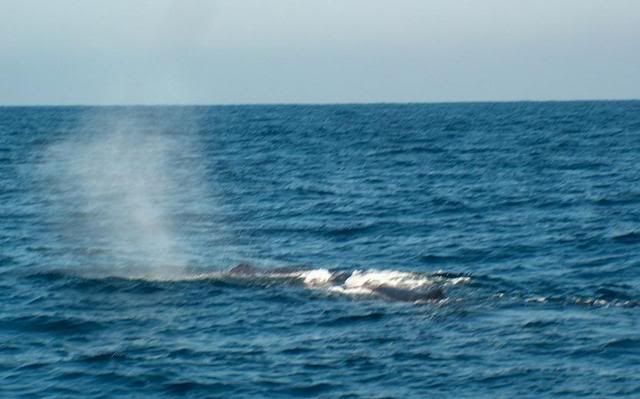
It's a good thing, if you could call anything that has to do with whaling "good", that Japanese coastal whaling, which occurs in the summer months, takes places only on the north coast, or these easily approached whales here on the south coast wouldn't stand a chance. Izumi asked for my help to broadcast his needs for support worldwide, and I have done some of that, and here I am, doing it again. If his business fails, dolphin-killing will resume. Consider him a Japanese Steve Hindi.
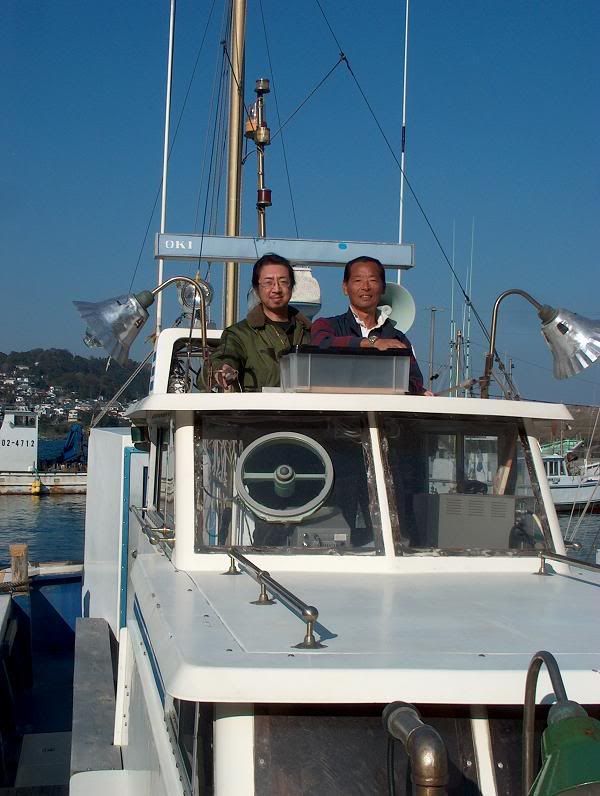
My visit of Shimonoseki was somewhat different. I was in company of my friend Bruce. Bruce and I hatched a plan to plant a magnetically mounted transmitting GPS unit on one of the whaling ships so that the Sea Shepherd ship would know where the whaling fleet would be at any given time. We arrived in Japan about 10 days before the usual departure date of the fleet, but we didn't know which city it would be for the whaling fleet to assemble prior to embarkation. My guess was Shimonoseki, but it was at the extreme western end of Honshu Island, and if I was wrong, we would have wasted a lot of driving. It could have been Osaka, for example, or Hiroshima. But I bet on Shimonoseki and that's where we went.
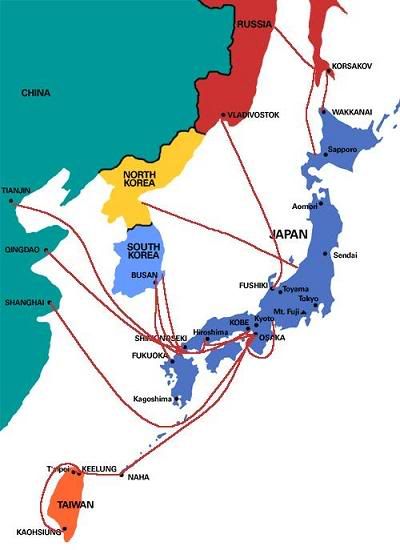
When we arrived in Simonoseki, it at once reminded me of Vancouver, if only scenery-wise, with an inlet, ocean-going ships, and even a suspension bridge like Vancouver's Lions Gate Bridge. While driving and walking around, we found that Bruce was the only Caucasia person in town, and he stuck out like a sore thumb. To walk with him in the open was to invite suspicious glances from passers by.
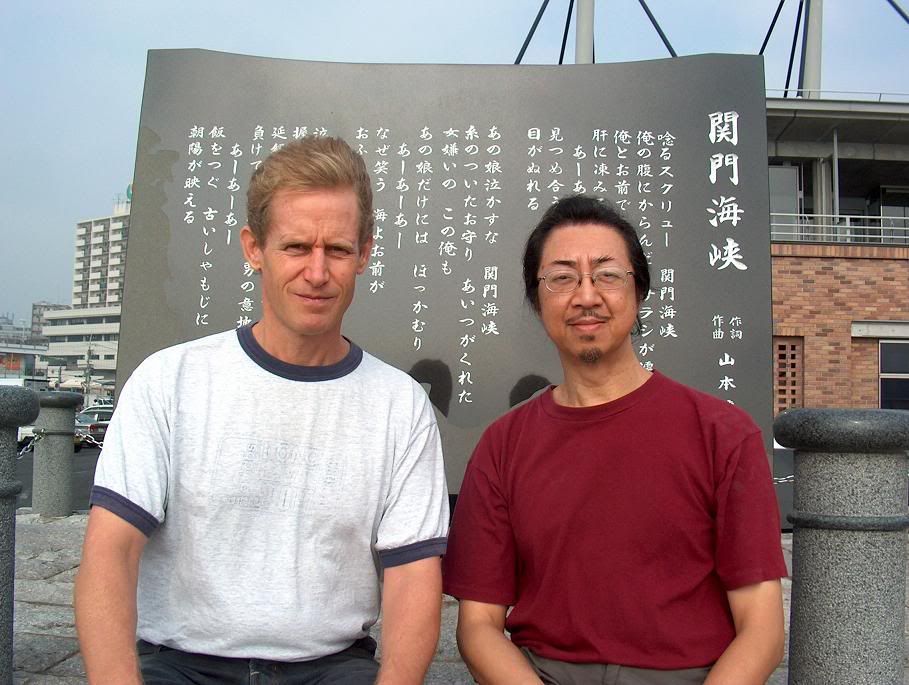
At one point, when we were walking along a dock, we were intercepted by a uniformed officer of some kind, and asked what we were doing in Shimonoseki. We said that we were tourists. After a few more questions, we were reluctantly let go. When we were pulling away in the rental car, I saw him talking on his cell phone, while still looking at the car. We drove along the sea front, and entered a busy mooring area where indeed we located a whaling vessel, though it did not look like any of the Antarctic ships I've seen on television and in videos. Not long after, we sighted one of the harpoon ships - the Yushin Maru. No doubt about this one. We patted one another on the back.
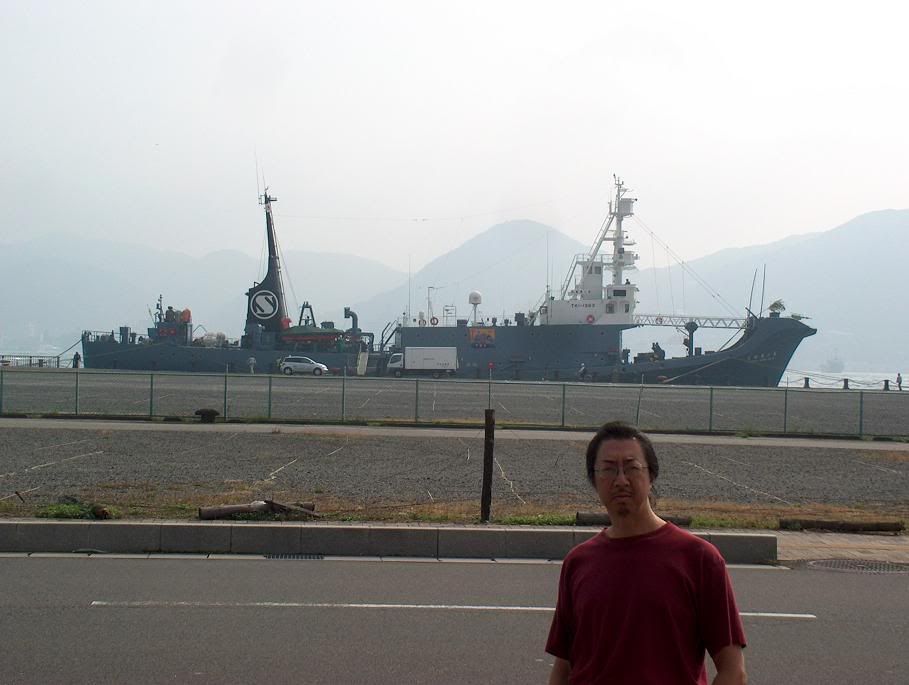
We rented a hotel room near the waterfront, and Bruce called the GPS outfit to have the unit shipped to hotel ASAP. We did not want to carry the unit with us while flying from Vancouver to Tokyo, for fairly obvious reasons.
For the next two days, Bruce and I walked and drove around in Shimonoseki, together and separately. I entered a supermarket and saw shelves and shelves of whale meat,

some labeled as "Health Food" in spite of the sky-high levels of mercury in whale meat.
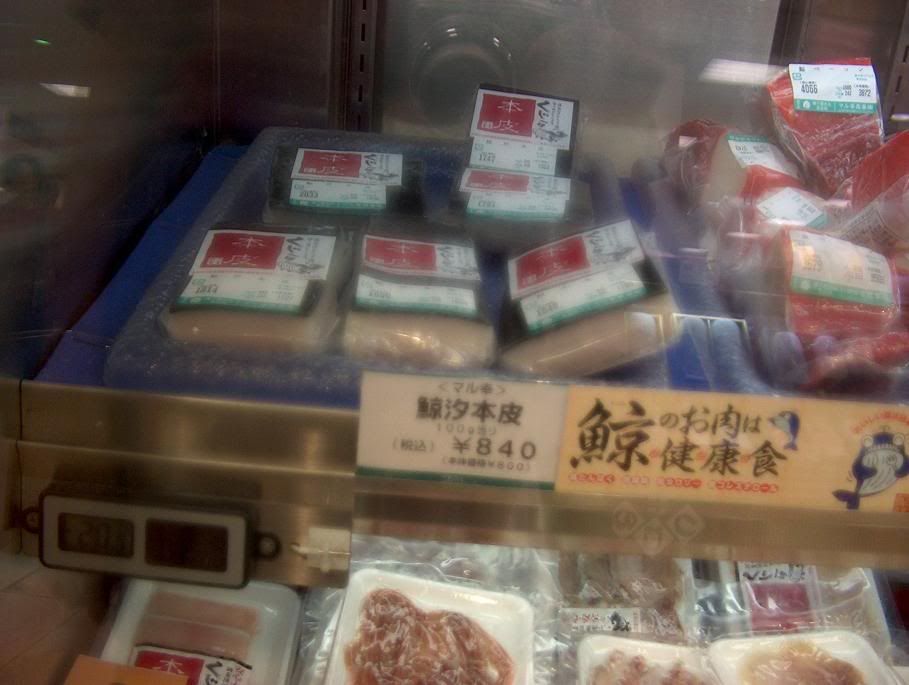
And a restaurant with a cubical menu of whale cuisine.
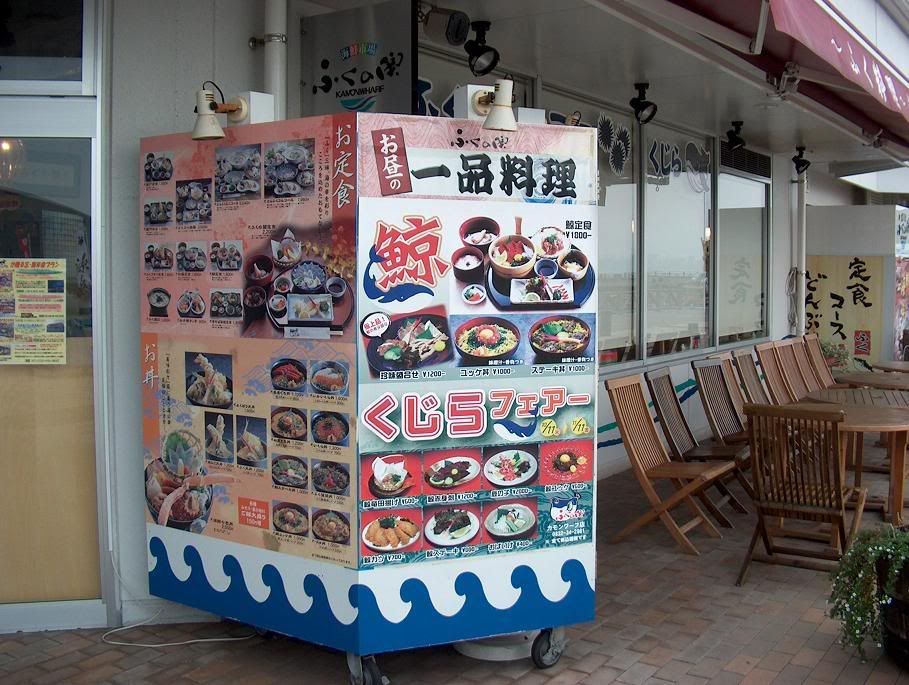
We visited the Shimonoseki Aquarium right on the waterfront, where captive dolphins were kept (guess where captured from?).
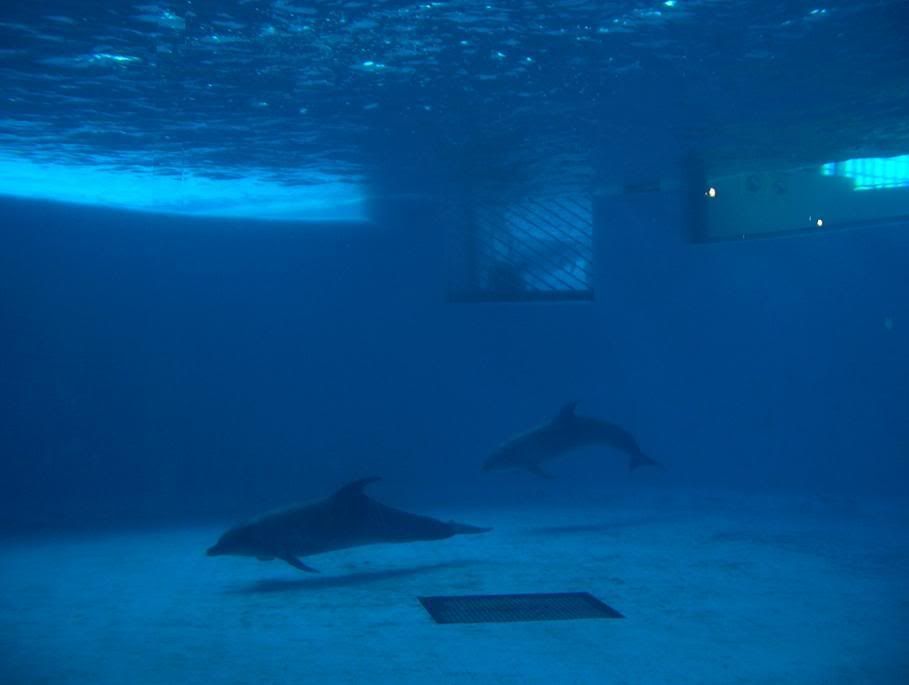
And there was a very tall observation tower from the top of which we could see the entire city 360. And it was from there that we spotted the factory ship the Nisshin Maru, tied up at the end of a pier protruding into the harbor. I knew who she was because on her side was painted, in huge white letters: RESEARCH.
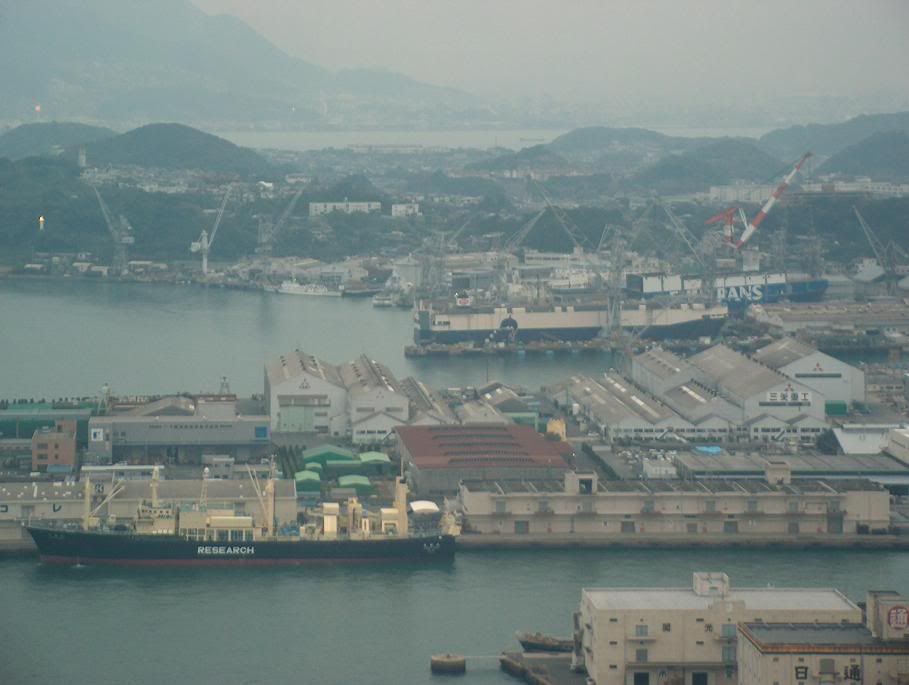
On the third day, we saw the entire whaling fleet, sans the Nisshin Maru, moored together right beside the Aquarium.
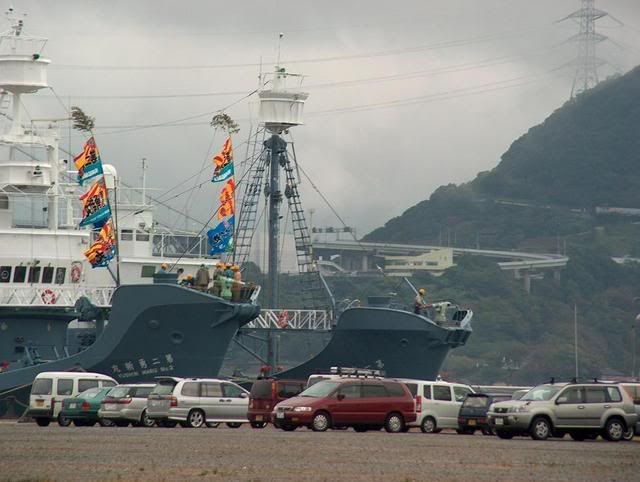
It was not cordonned off and the public, meaning us, could walk right up to the ships and touch them. There were gangplanks on two of the ships, and we could have walked right onboard and planted the GPS on some suitable surface.
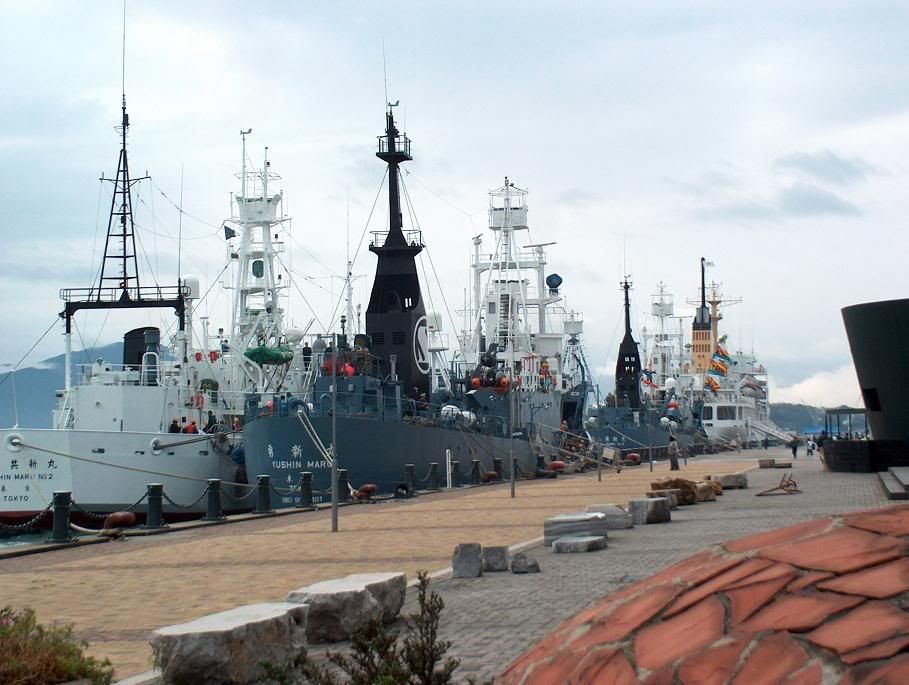
Unfortunately, the unit had not arrived. I took numerous pictures of the fleet, and, back in the hotel looked at them minutely to locate the best places for the unit. Not too many. Almost all surfaces were in one way or another unsuitable.
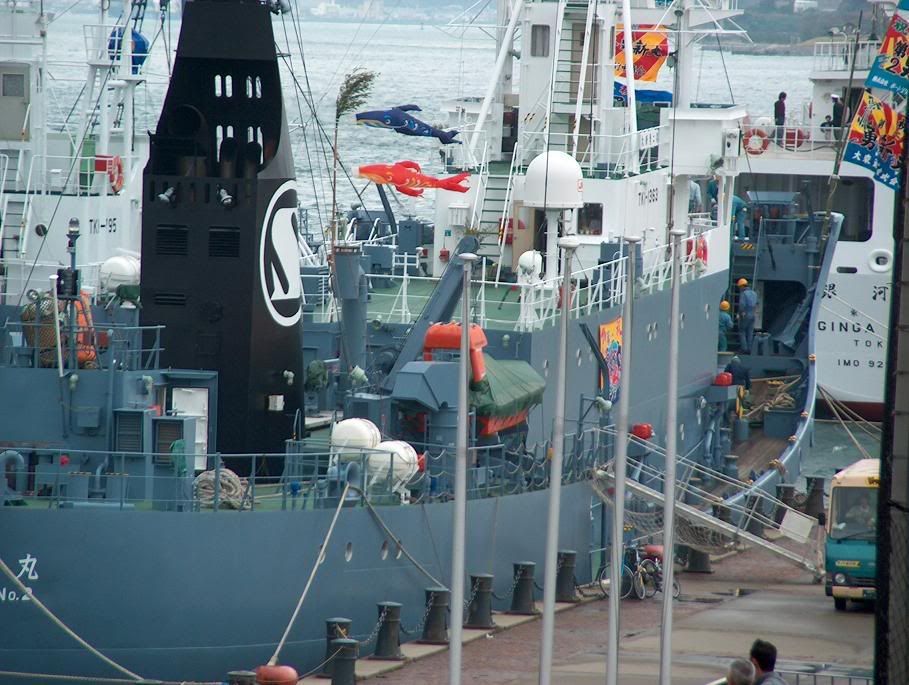
We decided to take a close look at the Nisshin Maru herself. I decided to go by myself, since Bruce's blondish hair shone like a beacon in the sun. My ponytail was enough of a red flag, since in all of Japan I've been to so far, I've seen only two men with a ponytail, one was a cool looking dude in a full riding suit with a sport motorcycle in a rest stop, and the other was in any mirror I happened to look into. So, I drove Bruce back to the hotel, then drove on to the parking lot of a shopping center fairly near the pier at which the Nisshin Maru was docked, and parked down the car. Then I walked down to the pier with my camera.
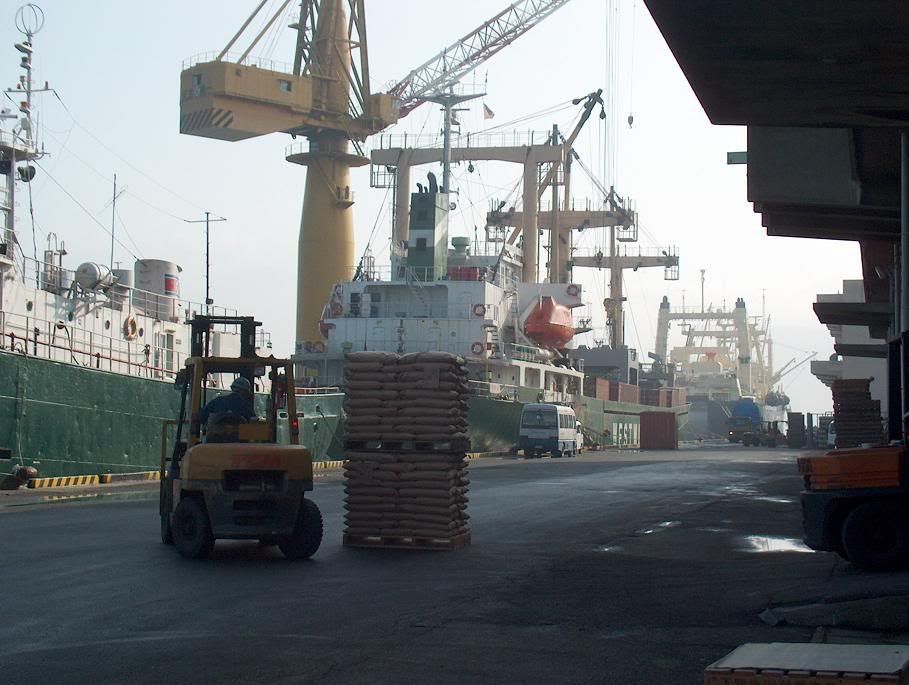
It was gated, but the gate was open and unguarded. The place was swarming with dock-workers, including some obviously in a supervisory position. As nonchalantly as possible, I walked on to the pier, and saw that there were three ships tied to it in a row. Nearest land was a South Korean freighter, then a Chinese freighter, and then, farthest out, was the Nisshin Maru.

I feigned interest in the Chinese freighter, and quite openly took a number of picture of that ship, first from astern, then amidships, and then from the bow. And when I was at the bow of the Chinese ship, I was at the stern of the Nisshin Maru, with her stern slipway yawning within yards of me. At that point, the vision of me in a black wet suit swiming to the stern and entering the ship by creeping up its slipway like a ninja in the night formed itself in my mind.

I had ventured into the Nisshin Maru's territory now. Still pretending interest in the Chinese ship, I snapped photos of the mother ship at close quarters. There were yellow-helmeted workers on board and on the dock, and a few gave me glances. I had absolutely no legit reason to be where I was, but I wanted to stick around longer to make observations over time. So I pulled out my cell phone, pretending to be talking into it, and while doing so, began strolling back and forth, in as relaxed a posture as I could muster, in plain view. I even waved my other arm while saying absolutely nothing. Gradually, the strolling brought me back to the stern slipway, and and the plan consolidated itself in my mind.
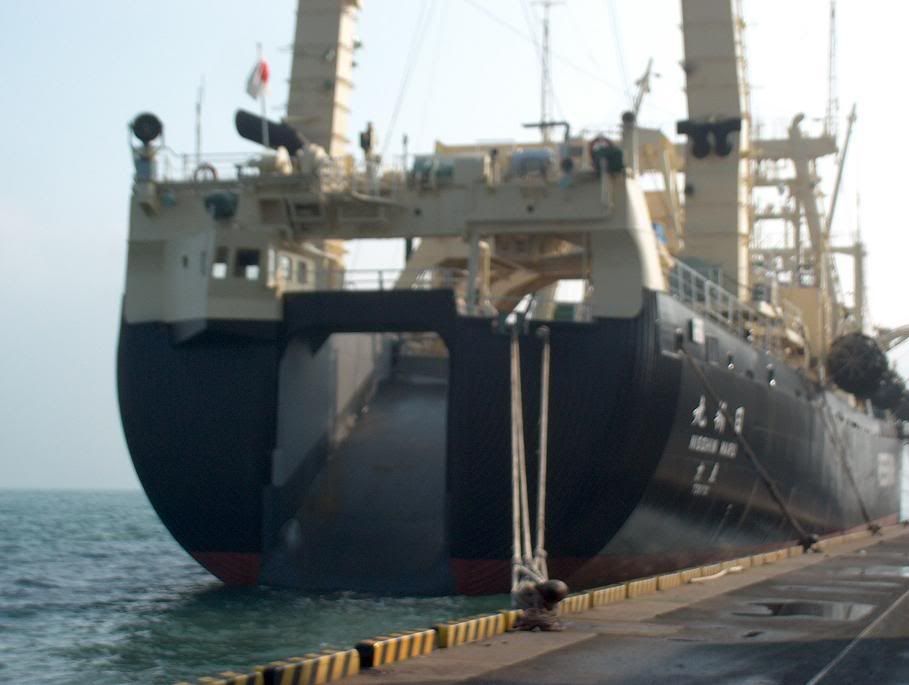
At that point, I saw a plain-clothes person walking purposefully towards me. I resumed my "cell phone conversation", in Chinese. He stopped about 20 feet from me, and waited. As naturally as possible, I said Joy Geen on the phone and closed it up. The guy walked up to me and ask me questions in Japanese. I answered "mm sig gong yud boon wa" ("I don't speak Japenese" in Cantonese.) He made a "wait" gesture, and walked off. I thought I'd better get the hell out of there, and began walking back towards the exit. It was a long walk if what you wanted to do was to run. The gate was about 200 yards away, and it felt like two miles. I forced myself to slow down, but my heart was pumping 150 a minute.
Finally I was outside the gates. Then, I began walking faster back towards the shopping center. In doing so, I had to walk along the waterfront for about a quarter mile before turning inland. Soon, I came across a row of small freighters tied up along the water front with their sterns tied to the landings, their bows pointed seaward, and gaps wide enough for smaller boats in between.
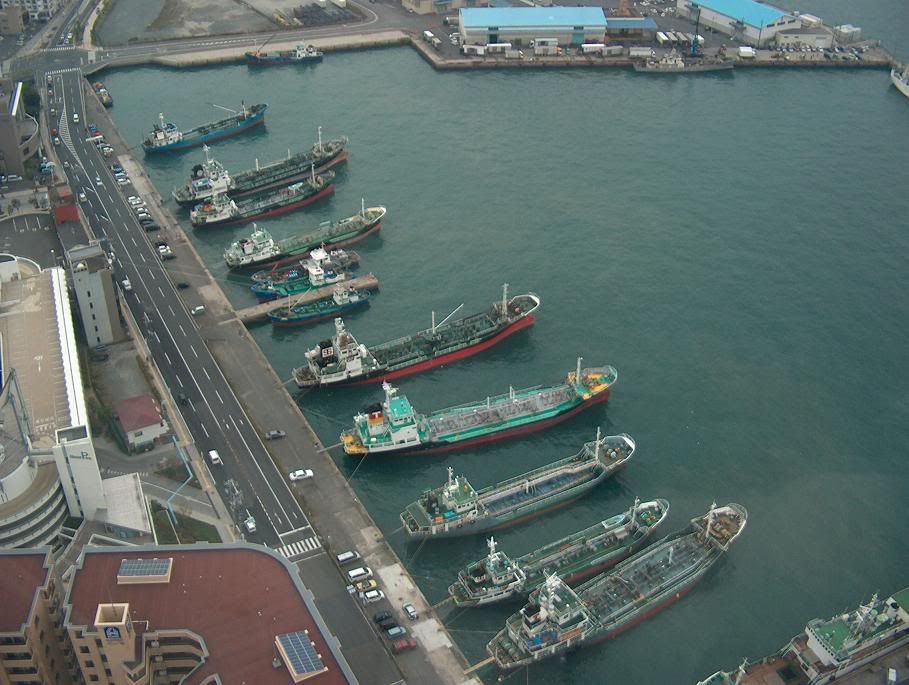
In case I was being followed, I stopped to take a few pictures of these small freighters, in short, to dilute my interest in the Nisshin Maru as much as possible. But at about mid-row, a small white van passed me from behind and came to an abrupt halt right in front of me. Two plain-clothes men stepped out, one being the one who had intercepted me at the dock. The other one began questioning me in Mandarin. I told him that my Chinese dialect was Cantonese, in Cantonese, which he did not understand. Then he switched to English. I thought about saying "No speak English", but given my Canadian passport, I didn't think I could get away with it. So, I answered him in English.
Speaking of my passport, that was the first thing he asked for. I knew that it was in the hotel room, but I didn't want to take them there because of Bruce, so I said I left it in my car. He asked me where the car was, and I told him. He said, "Let's go." I was afraid he might tell me to get in their van, which conjured images of kidnappings and abductions and disappearances. As if reading my mind, he said something to his companion in Japanese, who went back to the van. He then told me to walk with him to the rental car. His companion tailed us at a snail's pace in the van, no doubt just in case I decided to make a dash for it.
The rest of this story cannot be told openly. Suffice to say that Bruce and I survived our Shimonoseki adventure intact. And while he headed back to Tokyo to catch his plane back to Canada, I carried on to Taiji. But that was another story, which was the one I wanted to tell in the first place.
Why did I write this article? Maybe I want to show to all the adrenaline junkies out there that there is a meaningful way to have fun.
Anthony Marr, founder and president
Heal Our Planet Earth (HOPE)
www.HOPE-CARE.org
www.MySpace.com/AnthonyMarr
www.YouTube.com/AnthonyMarr
www.HomoSapiensSaveYourEarth.blogspot.com
www.ARConference.org
www.AnimalVoices.org
1 comment:
Wow, these are the best, closest, clearest, and the only pictures that I have seen with so many Japanese Whaling ships in the pictures. I have looked all over the internet for good pictures to study the fleet and all the ships they have used in the last couple decades or so and what they use now for whaling. I watch this fleet like a hawk and find out anything I can about what they are using, what they are doing, their location of the ships, and what mships they will use for the next season of whaling and then turn around and report anything about this fleet back to the Sea Shepherds so they can make the decisions and be able to mobilize to get the fleet and more importantly, the Nisshin Maru.
Post a Comment